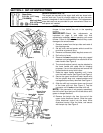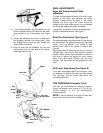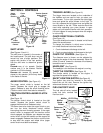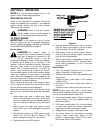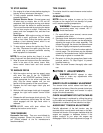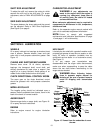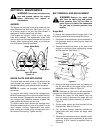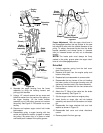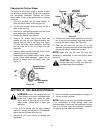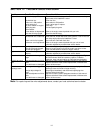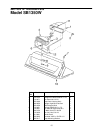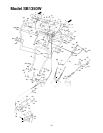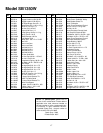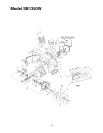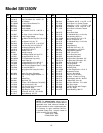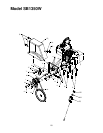
13
Changing the Friction Wheel
The rubber on the friction wheel is subject to wear
and should be checked after 25 hours of operation,
and periodically thereafter. Replace the friction
wheel rubber if signs of excessive wear or cracking
are found.
1. Drain the gasoline from the snow thrower, or
place a piece of plastic under the gas cap.
2. Tip the snow thrower up and forward, so that it
rests on the housing.
3. Remove six self-tapping screws from the frame
cover underneath the snow thrower.
4. Remove the wheels from the axle.
5. Using a 7/8” wrench hold the hex shaft and
remove the hex nut and cupped washer and
bearing from left side of the frame. See Figure
15. Hold the friction wheel assembly, and slide
the hex shaft out of the unit toward the right
hand side.
6. Remove the six screws from the friction wheel
assembly (three from each side).
7. Reassemble new bonded friction wheel rubber
to the friction wheel assembly, tighten the six
screws in rotation and with equal force. See
Figure 22.
Figure 22
Figure 23
8. Position the friction wheel assembly up onto the
pin of the shift rod assembly and slide the shaft
through the friction wheel. See Figure 23.
9. Slide the hex shaft into the hex I.D. of the
sprocket, the spacer and the left ball bearing and
secure with the bell washer and hex bolt.
NOTE: Make sure the pin from the shift arm
assembly is assembled to the new friction wheel
assembly.
CAUTION: Check engine and snow
thrower frequently for loose nuts, bolts, etc.
and keep these items tightened.
SECTION 10: OFF-SEASON STORAGE
WARNING: Never store engine with fuel
in tank indoors or in poorly ventilated areas
where fuel fumes may reach an open
flame, spark or pilot light as on a furnace,
water heater, clothes dryer or other gas
appliance.
1. If unit is to be stored over 30 days, prepare
engine for storage as instructed in the separate
engine manual included with your unit.
2. Remove all dirt from exterior of engine and
equipment.
3. Follow lubrication recommendations on page 10.
4. Store in a clean, dry area.
NOTE: When storing any type of power equipment
in an unventilated or metal storage shed, care
should be taken to rust proof the equipment. Using a
light oil or silicone, coat the equipment, especially
any chains, springs, bearings and cables.
Bonded Friction
Wheel Rubber
Hex Self-tapping
Screws
Spacer
Sprocket
Support
Pin
Bracket
Shaft
Shift Rod
Friction Wheel
Assembly
Assembly



